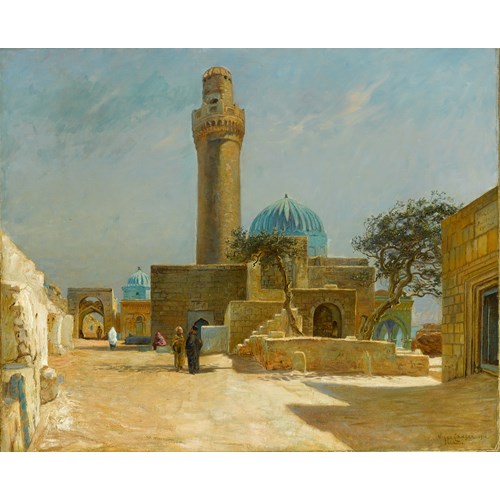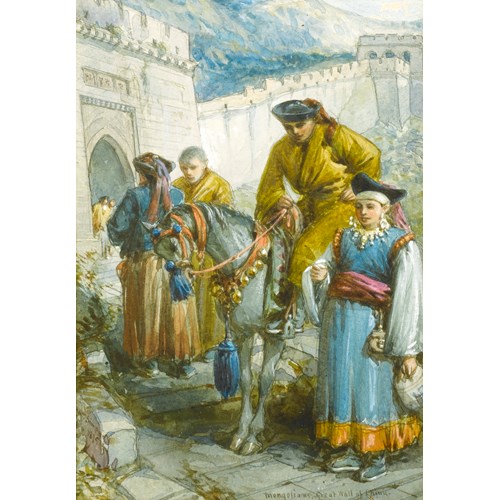Marketplace
The Roman Forum
Karl Pavlovich Bryullov
The Roman Forum
Date 1836
Period 1750-1850, 19th century
Origin Russia
Medium Watercolour on paper
Dimension 37 x 51 cm (14⁵/₈ x 20¹/₈ inches)
In Drawings and Watercolours in Russian Culture, Yevgenia Petrova writes that in Karl Pavlovich Bryullov’s paintings, ‘features of a Romantic perception of the world were closely linked to the classical relationship with art, the world and its ideals’.¹ In this beautifully composed and evocative view of the Roman Forum, Bryullov demonstrates his academic grounding in Classicism, combined with the Romanticist tendencies that brought him renown. ‘The Great Karl’, as he was known to his contemporaries, was a pivotal early nineteenth-century artistic figure, straddling the schools of neo-Classicism and Romanticism, and was the first Russian painter to gain widespread recognition in Europe.
The warm Mediterranean lighting and pleasant hues of The Roman Forum are compelling and Bryullov’s draughtsmanship is remarkable. In his later years, when teaching at the Imperial Academy of Arts, he told his students: ‘It is necessary to be able to draw before being an artist, because drawing constitutes the basis of art, the mechanism should be developed from early years so that the artist, beginning to reflect and feel, conveys his thoughts faithfully and without any complication: so that the pencil runs after the will of thought: the thought turns and the pencil should turn also’.² In The Roman Forum, Bryullov illustrates his point, as the delicacy of line complements the naturalness and harmony of the composition, helping to express the mood of the scene.
During his extensive travels through Europe Bryullov executed many works comparable to The Roman Forum, which focus on antiquity. His watercolour Temple of Apollo at Phigalia, similarly shows the ruined carcass of an ancient building, which, despite its state of disrepair, retains a sense of Classical grandeur. As life continues around them the buildings imbue the landscapes in which they sit with a sense of timelessness and history which clearly appealed to Bryullov.
Bryullov was born into an artistic family and showed an outstanding talent for drawing at an early age. He studied at the Imperial Academy of Arts from 1809 to 1822 and graduated with a first-class gold medal. He was sponsored on a journey to Italy, along with his brother, by the Society for the Encouragement of Arts in 1822. He remained there for thirteen years, working in Milan, Naples and Rome, where he painted his most famous work, The Last Day of Pompeii (Russian Museum, St. Petersburg). This dramatic and powerful piece, combining Renaissance Classicism with realism and intensity of emotion, was inspired by archaeological research, Pliny’s (23-79) account, and Pacini’s (1796-1867) opera of 1825 based on the historical event. The painting gained widespread admiration in Rome and throughout Europe, was praised by Sir Walter Scott (1771-1832) and was also the subject of a poem by Alexander Pushkin (1799-1837). A contemporary claimed that, ‘the last day of Pompeii became the first day of Russian painting’.
Having cemented his reputation as one of the finest European painters of his day, Bryullov triumphantly returned to St. Petersburg in 1835, where he enjoyed a privileged place among the aristocracy and intellectual elite of the city.
Bryullov quickly became professor of the Imperial Academy of Arts and was also a professor of the Accademia di Belle Arti in Florence, in addition to contributing to exhibitions in Rome, Milan and Paris. With his health deteriorating Bryullov left Russia for Madeira in 1849. He spent the last three years of his life in Rome and was buried in the Cimitero degli Inglesi.
¹ Petrova, Y., Drawings and Watercolours in Russian Culture: The First Half of the Nineteenth Century, (Palace Editions, St. Petersburg, 2005), p. 32.
² ibid, p. 105.
The warm Mediterranean lighting and pleasant hues of The Roman Forum are compelling and Bryullov’s draughtsmanship is remarkable. In his later years, when teaching at the Imperial Academy of Arts, he told his students: ‘It is necessary to be able to draw before being an artist, because drawing constitutes the basis of art, the mechanism should be developed from early years so that the artist, beginning to reflect and feel, conveys his thoughts faithfully and without any complication: so that the pencil runs after the will of thought: the thought turns and the pencil should turn also’.² In The Roman Forum, Bryullov illustrates his point, as the delicacy of line complements the naturalness and harmony of the composition, helping to express the mood of the scene.
During his extensive travels through Europe Bryullov executed many works comparable to The Roman Forum, which focus on antiquity. His watercolour Temple of Apollo at Phigalia, similarly shows the ruined carcass of an ancient building, which, despite its state of disrepair, retains a sense of Classical grandeur. As life continues around them the buildings imbue the landscapes in which they sit with a sense of timelessness and history which clearly appealed to Bryullov.
Bryullov was born into an artistic family and showed an outstanding talent for drawing at an early age. He studied at the Imperial Academy of Arts from 1809 to 1822 and graduated with a first-class gold medal. He was sponsored on a journey to Italy, along with his brother, by the Society for the Encouragement of Arts in 1822. He remained there for thirteen years, working in Milan, Naples and Rome, where he painted his most famous work, The Last Day of Pompeii (Russian Museum, St. Petersburg). This dramatic and powerful piece, combining Renaissance Classicism with realism and intensity of emotion, was inspired by archaeological research, Pliny’s (23-79) account, and Pacini’s (1796-1867) opera of 1825 based on the historical event. The painting gained widespread admiration in Rome and throughout Europe, was praised by Sir Walter Scott (1771-1832) and was also the subject of a poem by Alexander Pushkin (1799-1837). A contemporary claimed that, ‘the last day of Pompeii became the first day of Russian painting’.
Having cemented his reputation as one of the finest European painters of his day, Bryullov triumphantly returned to St. Petersburg in 1835, where he enjoyed a privileged place among the aristocracy and intellectual elite of the city.
Bryullov quickly became professor of the Imperial Academy of Arts and was also a professor of the Accademia di Belle Arti in Florence, in addition to contributing to exhibitions in Rome, Milan and Paris. With his health deteriorating Bryullov left Russia for Madeira in 1849. He spent the last three years of his life in Rome and was buried in the Cimitero degli Inglesi.
¹ Petrova, Y., Drawings and Watercolours in Russian Culture: The First Half of the Nineteenth Century, (Palace Editions, St. Petersburg, 2005), p. 32.
² ibid, p. 105.
Date: 1836
Period: 1750-1850, 19th century
Origin: Russia
Medium: Watercolour on paper
Signature: Signed ‘C. Brulloff’ (lower left); inscribed and dated ‘Rome le 20 Mai 1836’ (verso).
Dimension: 37 x 51 cm (14⁵/₈ x 20¹/₈ inches)
More artworks from the Gallery







_T638989902574827885.jpg?width=500&height=500&mode=pad&scale=both&qlt=90&format=jpg)

